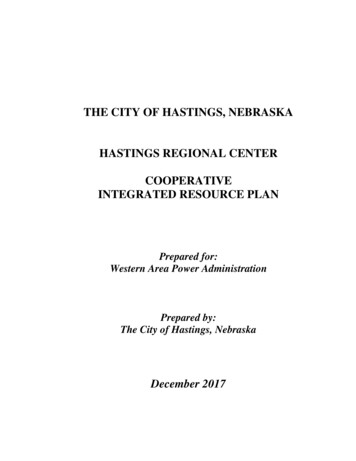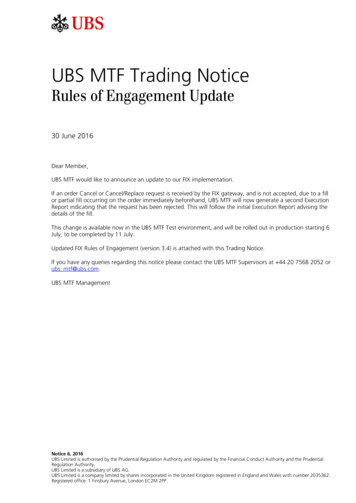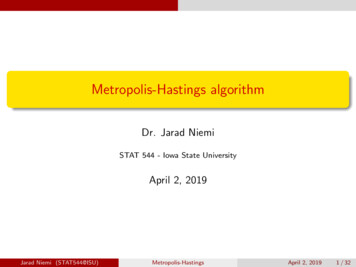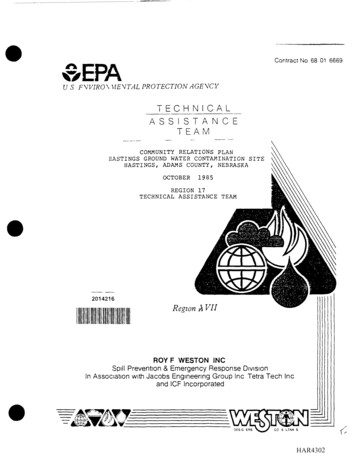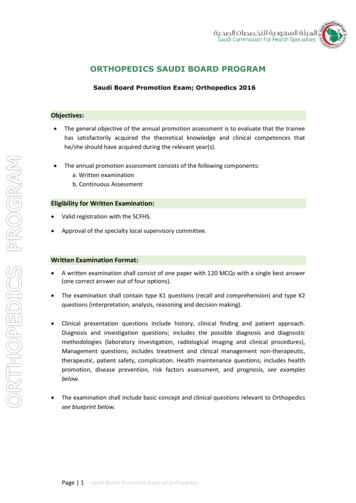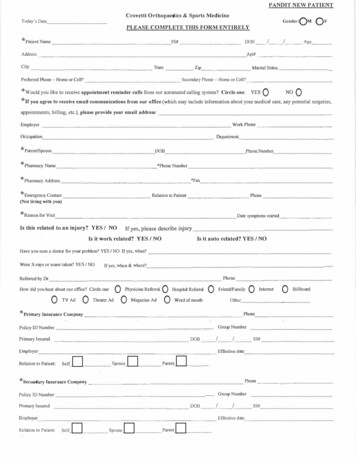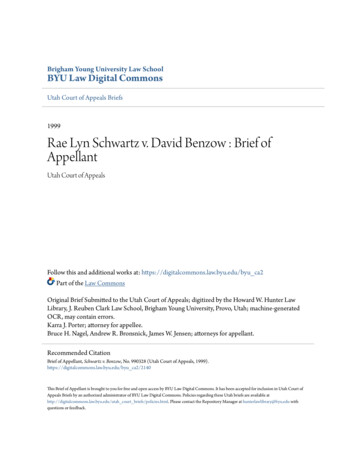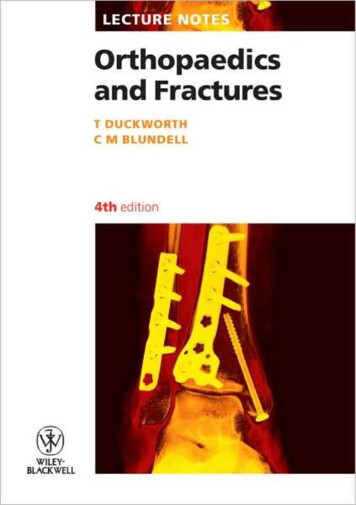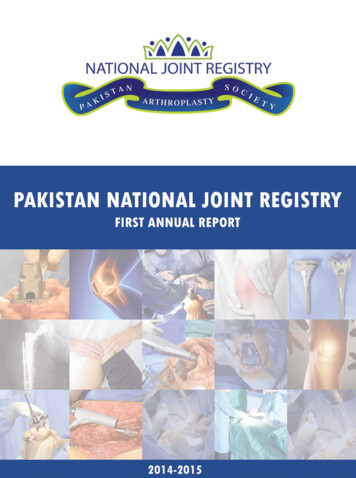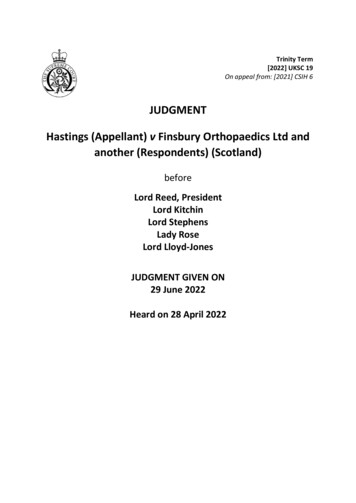
Transcription
Trinity Term[2022] UKSC 19On appeal from: [2021] CSIH 6JUDGMENTHastings (Appellant) v Finsbury Orthopaedics Ltd andanother (Respondents) (Scotland)beforeLord Reed, PresidentLord KitchinLord StephensLady RoseLord Lloyd-JonesJUDGMENT GIVEN ON29 June 2022Heard on 28 April 2022
AppellantRobert Weir QCRobert Milligan QCClare Connelly(Instructed by Thompsons Solicitors (Scotland) (Glasgow))Respondents (Finsbury Orthopaedics Ltd and Stryker UK Ltd)Kenny McBrearty QCAlexander Antelme QCDavid MyhillEwen Campbell(Instructed by Kennedys Law LLP (London))
LORD LLOYD-JONES: (with whom Lord Reed, Lord Kitchin, Lord Stephens and LadyRose agree)1.In 2009 the appellant, Mr John Hastings, underwent a metal-on-metal (“MoM”)total hip replacement (“THR”). The prosthetic hip used (“the MITCH–Accoladeproduct”) was manufactured by the respondents, each making separate parts. In 2012the appellant underwent revision of the hip implant in his left hip.2.The appellant claims that the replacement hip used in 2009 was defective andseeks damages under section 2 of the Consumer Protection Act 1987 (“the CPA”). Theissues in the present case were limited at first instance to the question of whethercertain propensities and risks inherent in MoM prosthetic hips rendered the particularcombination of components used in the appellant’s operation defective within themeaning of section 3 of the CPA.3.In the Outer House the Lord Ordinary (Lord Tyre) held after a preliminary proofthat the appellant had failed to prove that the particular product was defective. TheInner House (Lord President (Lord Carloway), Lord Menzies and Lord Woolman)refused the appellant’s reclaiming motion. The appellant now appeals against the FirstDivision’s decision refusing the reclaiming motion. In the event that the appeal issuccessful the appellant seeks remission of the case to the Lord Ordinary to deal withany remaining issues of liability, causation and quantum.The Directive and the CPA4.The CPA implemented the Directive of the Council of the EuropeanCommunities, dated 25 July 1985 (No 85/374/EEC) on the approximation of the laws,regulations and administrative provisions of the member states concerning liability fordefective products (the “Directive”).5.The preambles to the Directive provided in relevant part:“ Whereas approximation of the laws of the member statesconcerning the liability of the producer for damage caused bythe defectiveness of his products is necessary because theexisting divergences may distort competition and affect themovement of goods within the common market and entail adiffering degree of protection of the consumer againstPage 2
damage caused by a defective product to his health orproperty;Whereas liability without fault on the part of the producer isthe sole means of adequately solving the problem, peculiarto our age of increasing technicality, of a fair apportionmentof the risks inherent in modern technological production; Whereas, to protect the physical well-being and property ofthe consumer, the defectiveness of the product should bedetermined by reference not to its fitness for use but to thelack of the safety which the public at large is entitled toexpect; whereas the safety is assessed by excluding anymisuse of the product not reasonable under thecircumstances;Whereas a fair apportionment of risk between the injuredperson and the producer implies that the producer should beable to free himself from liability if he furnishes proof as tothe existence of certain exonerating circumstances; ”6.Article 1 provided:“The producer shall be liable for damage caused by a defectin his product.”7.Article 4 provided:“The injured person shall be required to prove the damage,the defect and the causal relationship between defect anddamage.”8.Article 6.1 provided:“A product is defective when it does not provide the safetywhich a person is entitled to expect, taking all circumstancesinto account, including:Page 3
(a)the presentation of the product;(b)the use to which it could reasonably beexpected that the product would be put;(c)the time when the product was put intocirculation.”9.Article 7 provided statutory defences which it was for the producer to proveincluding:“(e) that the state of scientific and technical knowledge atthe time when he put the product into circulation was notsuch as to enable the existence of the defect to bediscovered; ”10.The CPA, as at the relevant date in 2009, provided in relevant part:“1(1) This Part shall have effect for the purpose of makingsuch provision as is necessary in order to comply with theproduct liability Directive and shall be construedaccordingly.”“2(1) Subject to the following provisions of this Part, whereany damage is caused wholly or partly by a defect in aproduct, every person to whom subsection (2) below appliesshall be liable for the damage.”11.It is common ground that the respondents, as producers of the MITCH-Accoladeproduct within section 2(2)(a), are persons within section 2(1).12.Section 3 defines “defect” as follows:“(1) Subject to the following provisions of this section,there is a defect in a product for the purposes of this Part ifthe safety of the product is not such as persons generally areentitled to expect; and for those purposes ‘safety’, in relationPage 4
to a product, shall include safety with respect to productscomprised in that product and safety in the context of risks ofdamage to property, as well as in the context of risks of deathor personal injury.(2)In determining for the purposes of subsection (1)above what persons generally are entitled to expect inrelation to a product all the circumstances shall be taken intoaccount, including (a)the manner in which, and purposes for which,the product has been marketed, its get-up, the use ofany mark in relation to the product and anyinstructions for, or warnings with respect to, doing orrefraining from doing anything with or in relation tothe product;(b)what might reasonably be expected to be donewith or in relation to the product; and(c)the time when the product was supplied by itsproducer to another;and nothing in this section shall require a defect to beinferred from the fact alone that the safety of a productwhich is supplied after that time is greater than the safety ofthe product in question.”13.Section 4 provides for defences and states in relevant part:“(1) In any civil proceedings by virtue of this Part againstany person (‘the person proceeded against’) in respect of adefect in a product it shall be a defence for him to show (e)that the state of scientific and technicalknowledge at the relevant time was not such that aPage 5
producer of products of the same description as theproduct in question might be expected to havediscovered the defect if it had existed in his productswhile they were under his control; ”14.In advance of the preliminary proof, the parties agreed the following questionfor the court:“Does the admitted inherent propensity of metal on metalhip prostheses to shed metal debris through wear in use(including trunnion wear), and the admitted risk that somepatients may suffer an adverse reaction to such metal debristhat may necessitate early revision, render the product lesssafe than persons generally were entitled to expect and thusdefective within the meaning of the [CPA], taking account ofall the circumstances, including the following particularcircumstances relied upon by the pursuer:(1)The knowledge reasonably to be expected ofthe body of orthopaedic surgeons responsible foradvising patients as to the choice of prosthesis, preand post supply;(2)The sufficiency of disclosure of the likelihoodand severity of such risks of the product within theliterature supplied in relation to the product, includingthe Instructions for Use; in particular having regard topoint 1;(3)Advice and warnings issued by the relevantregulatory authorities post supply;(4)Advice and warnings issued by themanufacturers and suppliers post supply;(5)The combination of a titanium alloy stem and acobalt chromium head;Page 6
(6)The date of supply of the product;(7)The fact that the product is no longersupplied?”The application of the CPA15.This appeal is unusual in that the legal issues concerning the application of theCPA are largely agreed. The basic principles may be summarised as follows:(i)The Directive and the CPA have introduced a system of no-fault liability.The concept of “defect”, introduced by the Directive and implemented by theCPA, is an autonomous one, defined in terms of failure of the product to meetan objective standard of safety that the court must evaluate.(ii)The test of whether a product is defective is whether the safety of theproduct is not such as persons generally are entitled to expect. The test is notwhat is expected but one of entitled expectation. The test is an objective one.The standard of safety is measured by what the public at large is entitled toexpect.(iii) What persons generally are entitled to expect is assessed having regardto all the circumstances which are factually or legally relevant to the evaluationof safety, including the matters identified in section 3(2). This must be evaluatedat the time when the product was supplied by its producer to another. Theassessment of risks associated with a product, which might inform entitledexpectations as to its safety, must be done at the time the product is suppliedand not with the benefit of hindsight.(iv) In determining whether a product met the level of safety personsgenerally were entitled to expect, the court is entitled to have regard toeverything now known about it that is relevant to that enquiry, irrespective ofwhether that information was available at the time it was put on the market orhas come to light subsequently.(v)The burden of proof is on the consumer to establish a defect and a causallink to the injury. The standard and means of proof are matters for national law,subject to the principle of effectiveness.Page 7
(See Wilkes v DePuy International Ltd [2016] EWHC 3096 (QB); [2018] QB 627, paras66, 76, 96 per Hickinbottom J; Gee v DePuy International Ltd, The DePuy PinnacleMetal on Metal Hip Litigation [2018] EWHC 1208 (QB), paras 84-86, 98, 139-141 perAndrews J; W v Sanofi Pasteur MSD SNC (Case C-621/15) [2017] 4 WLR 171 at paras 29,37-38.)The basis of the appellant’s case at proof16.At proof, it was common ground that the statistical evidence presented to thecourt was not sufficient of itself to enable the court to conclude that the product wasdefective. As a result, the appellant presented his case on two main bases.17.First, he sought to prove that the MITCH-Accolade product was defective bydemonstrating design flaws. In this regard, he maintained (a) that the metal debriscreated by the MITCH-Accolade product gave rise to a greater risk of an adverse effecton the patient and so a greater risk of early failure, in comparison with debrisproduced by non-metal-on-metal (“non-MoM”) prostheses, (b) that design features ofthe product created a greater risk of early failure than with non-MoM prostheses, and(c) that the outcome after revision was worse with the MITCH-Accolade product. Bothparties relied upon expert evidence in four fields: orthopaedics, biomechanics,immunology/toxicology and histopathology. Under each head the Lord Ordinaryrejected the appellant’s case: see paras 135, 146, 162. On appeal, there has been nochallenge to these conclusions.18.The second basis on which the appellant put his case at proof was to rely onmatters which were said to constitute prima facie evidence that the MITCH-Accoladeproduct was defective. Here the appellant relied in particular on (a) expressions ofprofessional concern by the orthopaedic community, (b) the conduct of therespondents in withdrawing the MITCH-Accolade product from the market and (c) thenotices and alerts issued by regulators and by the respondents. The appellantmaintained that these matters established that the MITCH-Accolade product wasdefective for the purposes of the CPA. The Lord Ordinary considered these matters inthe light of the expert evidence including the evidence of Professor Platt andconcluded that they did not establish a defect. The central question which arises onthis appeal is, as formulated by the Lord President in the Inner House (at para 71),whether the Lord Ordinary was, after a further consideration of the evidence entitledto reach a conclusion that, notwithstanding the prima facie evidence, the pursuer hadfailed to overcome the burden of proof.Page 8
Entitled expectation19.In this case the nature of the product is such that there can be no entitlement toan absolute level of safety. It is natural for a prosthesis of this sort to wear and to shedmetal debris that can cause soft tissue damage, so this of itself cannot be a defect: seeGee at para 117 per Andrews J. The test of entitled expectation was agreed by theparties and held by the Lord Ordinary (at para 119) to be whether, subject to deminimis considerations, the level of safety of the MITCH-Accolade product would notbe worse, when measured by appropriate criteria, than existing non-MoM productsthat would otherwise have been used.20.The Lord Ordinary adopted two criteria of entitled expectation. First, headopted the time to revision (also referred to as survivorship of the implant) whichwas considered by the expert witnesses to be a very important measure of implantperformance. Secondly, he considered that he should also have regard to theprospects of success of revision surgery as a relevant consideration in assessingwhether there was a failure to meet entitled expectation. With regard to the secondcriterion, the Lord Ordinary concluded that the appellant had not proved that metaldebris from MoM THRs created a risk that revision surgery would be less likely to leadto a satisfactory outcome than with other prostheses. On appeal, therefore, the solecriterion of entitled expectation has been time to revision.21.The judge emphasised that the proof was concerned with the MITCH-Accoladeproduct and not with MoM THRs in general. Accordingly, any findings he made had tobe based upon evidence relating directly or by necessary implication to the MITCHAccolade product. He noted that because of the short period during which the productwas on the market, such evidence was not in abundant supply.The statistical evidence: the evidence of Professor Platt22.At proof, the respondents relied upon evidence of biostatistics from ProfessorRobert Platt, Professor of Pharmacoepidemiology at McGill University, Canada. Theappellant agreed that Professor Platt’s evidence was unchallenged and his attendancefor cross-examination was not required. The appellant did not seek to call his ownexpert evidence on statistics. Furthermore, the parties were agreed that ProfessorPlatt’s evidence demonstrated that there was no reliable statistical evidence that therevision rate of the MITCH-Accolade product was out of line with the relevantbenchmarks.Page 9
23.The Guidance issued in 2000 by the National Institute for Health and ClinicalExcellence (“NICE”) stated that the best prostheses had a revision rate of 10% or less atten years and that this should be regarded as the benchmark in the selection ofprostheses for primary THR. A product would satisfy this benchmark if the 95%confidence interval of the Kaplan-Meier cumulative revision rates estimate for therelevant product included the benchmark revision rate. The UK Orthopaedic DataEvaluation Panel (“ODEP”) considered ten year outcome data to be the relevantminimum benchmark, and to characterise a THR product as “Class A”, ODEP required arevision rate of 3% or less at three years, 5% or less at five years, 7% or less at sevenyears and 10% or less at ten years. Again, under the ODEP approach, a productsatisfied the NICE Guidance if the 95% confidence interval of the Kaplan-Meiercumulative revision rate estimate for the product included the benchmark revisionrate.24.The Medical Device Alert (“MDA”) issued in April 2012 in respect of the MITCHAccolade product had stated a revision rate of 10.7% at four years. Professor Plattprovided an analysis based on data recorded in the UK National Joint Registry (the“NJR”) which showed a revision probability for the MITCH-Accolade product of 23.2%(95% CI 18.4-28.9%) at ten years, which was significantly worse than those for otherprostheses. However, Professor Platt concluded that the use of the NJR data as ameasure of survivorship would create a misleading impression for a number ofreasons.(i)The NJR data were incomplete. The omission of a patient from the datacould increase or decrease the estimated survivorship but the direction of biaswas unknown.(ii)Data on the MITCH-Accolade product suffered from small sample sizeswhich gave rise to wide confidence intervals and low certainty and limited themethodology available to detect outlier surgeons.(iii) There were few sources of survivorship estimates specific to the MITCHAccolade product.(iv) Survivorship estimates were only available for ten to 12 years of followup time which made it difficult to predict how survivorship estimates wouldevolve in the longer term. Only a few implants informed the estimates forlonger follow-up times.Page 10
(v)Survivorship estimates based on observational data could reflectconfounding (ie selection bias) in that patients’ selection of implant devicesmight be related to characteristics that also influenced expected survivorship.As a result, estimated differences in survivorship across implants or over timemight reflect differences in patient or doctor characteristics rather thandifferences in implant design. In the case of the MITCH-Accolade product, whichwas developed for young and/or active patients, the patients’ activity levelswere of particular importance but data on this was missing. As a result it wasnot possible directly to assess the effect of activity levels on implantsurvivorship, nor to differentiate between the effects of activity levels andimplant design when comparing survivorship across devices. Similarly, high bodymass index had been found to reduce implant survivorship and might alsoinfluence the choice of hip implant device but the recording of such data wassparse. In addition to biasing the comparisons of survivorship across devices,variation in patient characteristics might also make it difficult to project futuresurvivorship.(vi) A lower threshold for revision would, for reasons unrelated to devicedesign, decrease the observed survivorship of MoM implants. Furthermore,follow-up guidelines, which could vary from country to country and couldinfluence revision rates, further compounded comparisons of the survivorshipof MoM hip implants with benchmarks.(vii) There might be reasons why revision risk was higher among youngerpatients.(viii) Patient gender was another potentially important predictor ofsurvivorship. Most studies reported an increased risk of revision for men andthe MITCH-Accolade population had a higher proportion of males than thegeneral THR population.25.For these reasons, Professor Platt considered that inferences drawn from asimple comparison of MITCH-Accolade and overall THR revision rates would be biasedby differences in the underlying patient populations. Unless such a comparison wereappropriately adjusted for confounding factors including age, gender, health status andpossibly other factors such as activity level and body mass index, they would notprovide the basis for meaningful conclusions.26.Professor Platt also addressed the possible effect on the NJR figures of outliers ie surgeons whose revision rates differed significantly from the normal range. (BothPage 11
parties accepted in answer to questions at the hearing that outliers would have beenremoved from the NJR figures on which the benchmarks were based.) Professor Plattidentified one surgeon (who had carried out 18 MITCH-Accolade implants of which tenwere revised) as a potential outlier and a second surgeon (who had carried out 77MITCH-Accolade implants of which 25 were revised) as a borderline outlier. Thepatients implanted by the latter surgeon tended to have characteristics generallyassociated with lower, not higher risk of revision. When the revision rates of these twosurgeons were excluded, the ten year cumulative probability revision estimate for theMITCH-Accolade product fell from 23.2% (95% CI 18.4-28.9%) to 14.3% (95% CI 9.820.7%). Applying the ODEP’s principle that a device fell within NICE guidance if the 95%confidence interval of its Kaplan-Meier cumulative revision rate included thebenchmark revision rate, with the removal of the two outlier surgeons the MITCHAccolade product met NICE guidance.27.Professor Platt concluded (at para 161):“161. My examination of available data on revisions of theMITCH-Accolade product indicates that there are limited dataavailable to reliably estimate the survivorship of the MITCHAccolade and to compare its survivorship to other THRprostheses. When taking into consideration (1) the smallsample sizes for MITCH-Accolade prostheses and thecorrespondingly large uncertainty in survivorship estimates,(2) the substantial variation in revision rates across surgeons,(3) the notable differences in the characteristics of patientsimplanted with the MITCH-Accolade versus other hip implantproducts, and (4) the potential biases created by suchdifferences (as well as by differences in characteristics notrecorded in the data), I find no reliable evidence that thesurvivorship of the MITCH-Accolade is out of line withbenchmarks as of the time the product was introduced to themarket, as of the time the Pursuer’s hips were implanted,and as of today.”The analysis by the Lord Ordinary28.The Lord Ordinary accepted that expression of serious professional concerns,followed by the issuing of an official alert and the withdrawal from the market of anentire range of products constituted powerful prima facie evidence that thoseproducts were not performing in accordance with expectation. However, heconsidered that that was not necessarily the same as not performing in accordancePage 12
with entitled expectation. He correctly considered that, in assessing whether the latterhad been established, he was entitled to proceed with the benefit of hindsight and tohave regard to material that was available at proof which was not available in 2012when the MoM THRs ceased to be used.29.In the course of his very careful opinion, the Lord Ordinary identified twocriteria of entitled expectation in relation to the MITCH-Accolade product: time torevision (survivorship) and prospects of success of revision surgery. So far as the latterwas concerned, following a detailed examination of the evidence the Lord Ordinaryconcluded that the appellant had not established on the balance of probabilities thatmetal debris produced by MoM THRs such as the MITCH-Accolade product created arisk that revision surgery following failure of the primary implant would be less likely tolead to a satisfactory outcome than revision surgery following failure of a primaryimplant made of other materials. No point has been taken on this conclusion onappeal. As a result, we are concerned solely with the judge’s analysis of whether timeto revision gave rise to a breach of an entitled expectation.30.Observing that the proof was concerned with the MITCH-Accolade product andnot with MoM THRs in general, the Lord Ordinary observed that any finding must bebased upon evidence relating directly or by necessary implication to the MITCHAccolade product. He noted that of the expert witnesses Professor Pandit (therespondents’ orthopaedic expert) had never used the product, Professor Breusch (theappellant’s orthopaedic expert) had never implanted any MoM device and DrMcCarthy (the respondents’ histopathology expert) was also unfamiliar with this kindof MoM THR. Furthermore, he had not been referred to any article specific to theMITCH-Accolade product and it had not been suggested that any such article existed.As a result, he considered that it was necessary to make what he could of publisheddata in relation to the product, properly interpreted. In his view the evidence ofProfessor Platt was accordingly of importance.31.The Lord Ordinary referred to the NICE benchmark (that the best prosthesesdemonstrate a revision rate of 10% or less at ten years) and to the ODEP criteria forcategorising a THR product as Class A in relation to the NICE benchmark (revision ratesof 3% at three years, 5% at five years, 7% at seven years and 10% at ten years subjectto a 95% confidence interval). He noted that the MDA issued in April 2012 in relationto the MITCH-Accolade product referred to a revision rate of 10.7% at four years basedon 271 patients recorded by the NJR. Professor Platt provided an analysis based on theNJR supplier feedback data of the cumulative revision probability of the MITCHAccolade product, disclosing a figure of 23.2% (95% confidence interval 18.4%, 28.9%)at ten years. The figure for four years in the same table was 10.5% (95% CI 7.3%,14.8%). The Lord Ordinary observed that, so far as they went, the data from 2012Page 13
which informed the Medicines and Healthcare Products Regulatory Agency (“MHRA”)alert and the (latest available) data from 2018 were consistent in showing, prima facie,a revision rate for MoM THRs significantly worse than rates for available alternatives.32.However, the Lord Ordinary observed that the thrust of Professor Platt’s reportwas to demonstrate that use of these figures as a measure of survivorship wouldcreate a misleading impression. He then summarised the reasons given by ProfessorPlatt why registry data ought not to be used to measure current or to predict futuresurvivorship of hip implants. (These are set out at paras 24-27 above). The LordOrdinary found some of Professor Platt’s objections more persuasive than others. Heobserved that this may be a manifestation of the difference between proof to scientificstandard and the civil legal standard of proof on balance of probabilities. He would notdismiss use of the NJR data merely on the ground that the NJR register wasincomplete, unless there was evidence that the omissions created bias one way or theother. Nor would he regard difficulties in predicting future revision rates as a reason torefrain from reaching a view on survivorship on the basis of the evidence currentlyavailable. In addition, one or two of Professor Platt’s reasons could be viewed asdouble-edged: in relation to higher risk to younger patients receiving the MITCHAccolade implant, there might be argument about which was the cause and which theeffect. He was, however, convinced by Professor Platt’s other reasons why theavailable evidence in relation to revision rates of the product was not sufficient toestablish that it had a materially lower survivorship than other available products ornational standards. In the first place, he was satisfied that without adjustment of the2012 NJR revision rate to take account of the two identified outlier surgeons, it couldnot provide a foundation for a conclusion that the revision rate for the MITCHAccolade product was worse than that of alternative devices then available.Furthermore, the confounding factors identified by Professor Platt rendered it unsafeto draw a conclusion from the bare NJR data that the revision rate of the device wasbelow the entitled expectation of those who received it. He found, in particular, thatthe MITCH-Accolade product was to a significant degree implanted in the youngerand/or more active patients and that they were predominantly male. On the balanceof probabilities those factors were likely to have lowered the average survivorship ofthe MITCH-Accolade product, for reasons unconnected with the implant itself.33.The Lord Ordinary also accepted that revision rates for the MITCH-Accoladeproduct were likely to have been affected by the publicity accorded to MoM THRsgenerally by the MDAs and wider media coverage. In his evidence Professor Breuschhad acknowledged that there was a lowering of the threshold for revision surgerybecause of clinicians’ fears that they would otherwise have a complication that haddeveloped into something they could not satisfactorily deal with, and that this mayhave had an effect on revision rates. Professor Pandit had considered that the onlyexplanation for the dramatic rise in revision rates between 2009 and 2016 was aPage 14
lowering of the threshold for revision surgery. This was the result of a combination ofconcerns that all MoM implants were likely to have a poor outcome and reports in thewider media (not to date established as well-founded) that metal debris from MoMimplants could have broader systemic consequences. The Lord Ordinary accepted thatit was likely, on the balance of probabilities, that these factors would have had theeffect of increasing the revision rate in relation to the MITCH-Accolade product forreasons other than the performance of the product itself. They constituted a furtherreason not to treat the NJR data as a reliable indicator of the “success” of the product.34.The Lord Ordinary stated his conclusion in the following terms (at para 163):“In my opinion, for the reasons set out in the precedingparagraphs, the pursuer has not proved, on balance ofprobabilities, at the time his prostheses were supplied, either(a)that survivorship was worse for theMitch/Accolade product than for existing alternativeproducts that could have been implanted instead; or(b)that use of the Mitch/Accolade product gaverise to an increased risk that revision surgery, in theevent of its failure, would be unlikely to achieve assatisfactory an outcome as if the primary implant hadbeen one of the existing alternatives.I therefore find that the pursuer has not proved, on balanceof probabilities, that the entitled expectation in relation tothe Mitch/Accolade product at th
total hip replacement ("THR"). The prosthetic hip used ("the MITCH -Accolade product") was manufactured by the respondents, each making separate parts. In 2012 the appellant underwent revision of the hip implant in his left hip . 2. The appellant claims that the replacement hip used in 2009 was defective and
